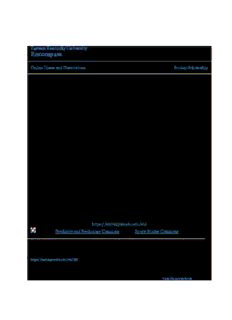
Physical, Emotional, and Competitive Aggression Tendencies in Contact and Non-Contact PDF
Preview Physical, Emotional, and Competitive Aggression Tendencies in Contact and Non-Contact
Eastern Kentucky University Encompass Online Theses and Dissertations Student Scholarship January 2014 Physical, Emotional, and Competitive Aggression Tendencies in Contact and Non-Contact Collegiate Athletes Samyra Rose Safraoui Eastern Kentucky University Follow this and additional works at:https://encompass.eku.edu/etd Part of thePsychiatry and Psychology Commons, and theSports Studies Commons Recommended Citation Safraoui, Samyra Rose, "Physical, Emotional, and Competitive Aggression Tendencies in Contact and Non-Contact Collegiate Athletes" (2014).Online Theses and Dissertations. 220. https://encompass.eku.edu/etd/220 This Open Access Thesis is brought to you for free and open access by the Student Scholarship at Encompass. It has been accepted for inclusion in Online Theses and Dissertations by an authorized administrator of Encompass. For more information, please [email protected]. PHYSICAL, EMOTIONAL, AND COMPETITIVE AGGRESSSION TENDENCIES IN CONTACT AND NON-CONTACT COLLEGIATE ATHLETES By SAMYRA ROSE SAFRAOUI Bachelor of Science University of South Florida Tampa, FL 2012 Submitted to the Faculty of the Graduate School of Eastern Kentucky University in partial fulfillment of the requirements for the degree of MASTER OF SCIENCE May, 2014 Copyright © Samyra Rose Safraoui, 2014 All rights reserved ii DEDICATION This thesis is dedicated to my mother for her unwavering love and support throughout my education. iii ACKNOWLEDGMENTS I would like to thank my committee chair, Dr. Joel Cormier, for his guidance, enthusiasm, and great patience as I completed this major project over the short span of one year. I would also like to thank Dr. Mathew Sabin, Dr. Dustin Wygant, and Dr. Heather Adams- Blair for their encouragement to keep moving through this process in an effective and timely manner. The support my committee formed for me was much appreciated and I thank all four members deeply. Outside of the committee, I would like to thank Dr. Eric Fuchs for his help in getting the final survey online and for his sincere interest in the present research. I would like to thank Dr. Daniel Mundfrom for the much needed review of statistics and even more so for his kindness when I asked such questions as “what exactly does effect size measure?” Once again, I would like to thank all of the professors at Eastern Kentucky University who contributed to the success of this thesis. Alongside my professors, I would like to thank the university athletics department and Simon Gray for allowing me to email the student-athlete population. In particular, I thank the sports medicine staff for their patience and cooperation as I attended thesis meetings during treatment hours and asked them to “read this sentence” or “look at that graph.” Jacob Ryan and Eugene Santos, I especially thank you for being there through all the good times and the bad. I would like to thank the 2014 track and field team of Eastern Kentucky University for their special patience and willingness to help in the research process. I especially thank my “recruitment crew” for the social media shout outs and Bratski runs. I would like to extend my sincerest gratitude to a future doctor of psychology, my friend and consultant at the Noel Studio, Alexandra Szarabajko, for proof reading the pages of this thesis with the careful and critical eye it deserved. Finally, I would like to thank my mother, to whom this project is dedicated for her love and support throughout the years of my life. My whole family, including close family friends, has helped me to achieve so much in my life and I would like to name them all but I am running out of room here. I will list as many as I can fit: Mom and Darin, Dad and Khadija, Johara, Malika, Nana, Barbara and Don, Danny, Patricia, Lala and Basidi, Betty, Billy, Adam, Kiersten. iv ABSTRACT Differences in aggression tendencies between athletes who play a contact sport and athletes who play a non-contact sport at the collegiate level were investigated. Specifically, emotional, physical, and competitive aggression tendencies were measured for both groups and then compared to each other using independent t tests and effect sizes. One hundred student- athletes from a medium sized midwestern university participated in the study, with an even split between contact and non-contact athletes. Student-athletes were sent an electronic survey via email and Survey Monkey; all materials were approved by the university’s Institutional Review Board (IRB) and Athletics department. It was determined that a significant difference exists between athletes who play a contact sport and athletes who play a non-contact sport. Athletes participating in a contact sport displayed higher levels of aggression in all three categories: emotional aggression, physical aggression, and competitive aggression. Football was the most aggressive sport in all three categories of aggression and golf was the least. Tennis scored higher than any other non-contact sport, particularly in emotional aggression. Soccer scored lower than any other contact sport and even lower than a few of the non-contact sports in competitive aggression. v TABLE OF CONTENTS CHAPTER PAGE I. Introduction 1 II. Literature Review 6 III. Methods 15 IV. Results 21 V. Discussion 33 List of References 43 Appendices 46 A. Informed Consent Page 46 B. Marlowe-Crown Social Desirability Scale 49 C. Buss-Perry Aggression Questionnaire 51 D. Competitive Anger and Aggression Scale 54 E. Mathematical Formulas 56 F. Open Ended Responses 58 vi LIST OF TABLES TABLE PAGE 4.1 Specific Sport Response Count 21 4.2 Gender Response Count 23 4.3 Academic Year Response Count 23 4.4 Injury Occurrence Response count 23 4.5 Aggression Means by Contact Level and Sport 24 4.6 B&P Emotional Aggression Summary by Contact Level 28 4.7 B&P Physical Aggression Summary by Contact Level 28 4.8 CAAS Competitive Aggression Summary by Contact Level 28 4.9 Aggression Means by Gender 29 4.10 B&P Emotional Aggression Summary by Gender 31 4.11 B&P Physical Aggression Summary by Gender 31 4.12 CAAS Competitive Aggression Summary by Gender 31 4.13 Social Desirability Outcomes 32 5.1 Response Rates by Sport 36 5.2 Response Rates from Each Email Attempt 39 vii
Description: